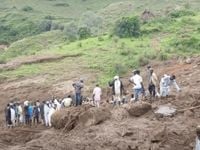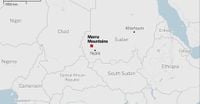In one of the most devastating natural disasters to strike Sudan in recent memory, a massive landslide obliterated the remote village of Tarasin in the Marrah Mountains of Darfur on Sunday, August 31, 2025. The catastrophe, triggered by days of relentless heavy rain, claimed the lives of more than 1,000 people—leaving only a single known survivor, according to statements from the Sudan Liberation Movement/Army (SLM/A), the rebel group controlling the area. The event has sent shockwaves through a nation already reeling from civil war, famine, and mass displacement.
Tarasin, nestled in the volcanic Marrah Mountains more than 900 kilometers west of Khartoum, was “completely leveled to the ground,” as the SLM/A described in a statement late Monday. “Initial information indicates the death of all village residents, estimated to be more than one thousand individuals, with only one survivor,” the group reported, as cited by Al Jazeera and the Associated Press. The SLM/A urgently appealed to the United Nations and international aid agencies for help in recovering the bodies of victims, including children, and in providing desperately needed humanitarian assistance.
Abdel-Wahid Nour, leader of the SLM/A, underscored the gravity of the situation in his appeal: “The scale and magnitude of the disaster are immense and defy description.” Footage shared by local outlets showed a flattened landscape between mountain ranges, with small groups of people searching for any sign of survivors or remains.
Al-Amin Abdallah Abbas, a farmer from the nearby cluster of villages known as Ammo, told the Associated Press, “The village and its people disappeared. It’s an unprecedented tragedy.” The affected region is so remote that it is accessible only by foot or donkey, with no roads for vehicles, making rescue and recovery efforts daunting if not impossible without outside help. BBC News reported that Antoine Gérard, the UN’s deputy humanitarian coordinator for Sudan, described the logistical nightmare: “We do not have helicopters, everything goes in vehicles on very bumpy roads. It takes time and it is the rainy season—sometimes we have to wait hours, maybe a day or two to cross a valley... bringing in trucks with commodities will be a challenge.”
The Marrah Mountains, rising more than 3,000 meters above sea level, are known for their cooler temperatures and higher rainfall compared to the surrounding arid plains. The region’s relative isolation has long made it a refuge for people fleeing violence in Darfur. As France 24 noted, the area is home to many displaced families who have sought shelter from the ongoing civil war between Sudan’s military and the paramilitary Rapid Support Forces (RSF), a conflict that erupted in April 2023 and has since devastated the country.
The ruling Sovereign Council in Khartoum released a statement mourning “the death of hundreds of innocent residents” in the Marrah Mountains’ landslide and pledged that “all possible capabilities” have been mobilized to support the area. Still, the reality on the ground is bleak. Most of Darfur, including the Marrah Mountains, remains largely inaccessible to international aid organizations due to the ongoing conflict, severely limiting the delivery of urgent humanitarian assistance. Doctors Without Borders has described the region as “a black hole” in Sudan’s humanitarian response, with communities “deprived of adequate assistance and neglected by aid actors for over two years.”
The timing could hardly be worse. Sudan is currently facing what the United Nations calls the world’s largest displacement and hunger crises. The civil war has killed more than 40,000 people, forced more than 14 million to flee their homes, and left some families eating grass in a desperate attempt to survive as famine spreads across parts of the country. The UN estimates that over 30 million of Sudan’s 50 million people are in need of some form of assistance, with more than 630,000 living in famine-stricken areas in Darfur and Kordofan.
Darfur’s army-aligned governor, Minni Minnawi, called the landslide a “humanitarian tragedy that goes beyond the borders of the region.” He appealed to international humanitarian organizations “to urgently intervene and provide support and assistance at this critical moment, for the tragedy is greater than what our people can bear alone.” The head of the African Union Commission, Mahmoud Ali Youssouf, echoed these calls, urging the warring parties “to silence the guns and unite in facilitating the swift and effective delivery of emergency humanitarian assistance to those in need.”
Yet, getting help to Tarasin and the surrounding villages is a monumental challenge. The area’s rugged terrain, lack of infrastructure, and ongoing violence all conspire to keep aid out. Mohamed Abdel-Rahman al-Nair, a spokesman for the SLM/A, told the Associated Press that the village is “remote and accessible only by foot or donkeys.” Even before the landslide, the area was marked by destitution, seclusion, and dire poverty, with residents living hand to mouth despite fertile land and abundant water, as Al Jazeera’s Mohamed Vall reported. “They have no schools, there are no traces of government in that area,” Vall noted.
The tragedy in Tarasin comes on the heels of other weather-related disasters in Sudan. Last year, heavy rainfall caused the collapse of a dam in the eastern Red Sea Province, killing at least 30 people, according to the United Nations. Seasonal rains from July to October routinely cause floods and landslides, but the scale of the Tarasin disaster is unprecedented in recent history.
The civil war has further complicated matters. While the SLM/A, which controls the Marrah Mountains, has mostly stayed out of the fighting, factions of the group have recently pledged to support the Sudanese military against the RSF. The paramilitary force, which lost much of central Sudan—including Khartoum—earlier this year, is now seeking to consolidate power in Darfur and establish a rival government. El-Fasher, the last major population center held by the army in Darfur, has been under RSF siege for more than a year, with civilians there facing what many describe as the fiercest assaults yet.
Allegations of war crimes and ethnic cleansing have dogged the conflict, with the International Criminal Court investigating claims of genocide and crimes against humanity. Many Darfuris believe the RSF and allied militias are attempting to transform the ethnically mixed region into an Arab-ruled domain, deepening long-standing tensions and fueling further displacement.
For now, the people of Tarasin—those who perished and the lone survivor—are grim reminders of the intersection between natural disaster and man-made catastrophe in Sudan. As the world’s attention turns, however briefly, to this remote mountain tragedy, the calls for urgent international action grow ever more desperate. Whether help will arrive in time, or at all, remains heartbreakingly uncertain.





